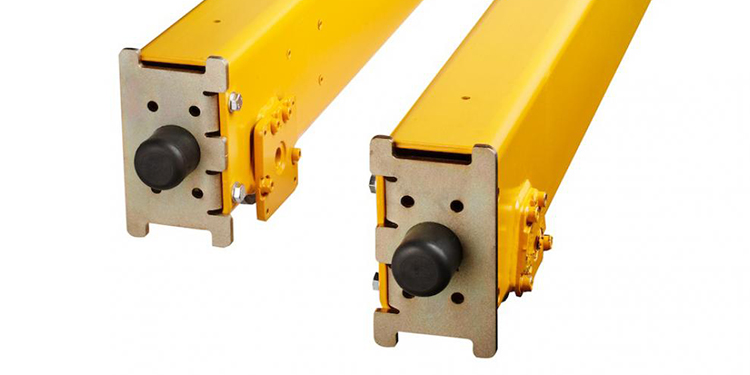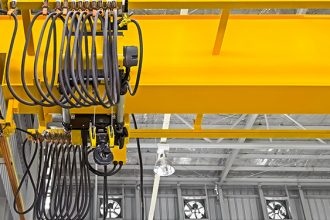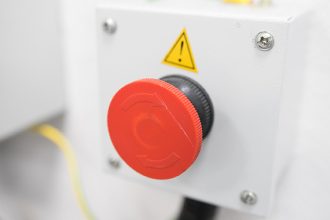How Trolley And Bridge Bumpers Stop Structural Damage To Cranes, Runways, And Buildings

Functioning much like the bumper on an automobile, trolley and bridge bumpers are devices that absorb the energy and reduce the impact when a moving crane or hoist trolley reaches the end of its permitted travel — or when two moving cranes or trolleys come into contact. They come in a variety of materials, including rubber, polyurethane, spring, or hydraulic, and are designed to engage directly with the rail end stops.
While trolley and bridge bumpers are a relatively small part of an entire overhead lifting system, they are a vital component of the equipment’s overall safety. Requirements for their use are covered in three separate standards: the Crane Manufacturers Association of America CMAA Specification 70, section 4.14; the Occupational Safety and Health Administration’s OSHA 1910.179 (e)(2) and (e) (3); and the American Society of Mechanical Engineers’ standard ASME B30.2: Overhead and Gantry Cranes, section 2-1.8.
All three standards state that every bridge and trolley supplied will be provided with bumpers (or another device that creates the same impact-absorbing effect). Additionally, the three specifications outline the following minimum characteristics of the bumpers:
- They must be engineered with enough energy absorbing capacity to stop the crane when traveling with power off in either direction at a speed of at least 40% for bridge motion, or 50% for trolley motion.
- They must be capable of stopping a crane’s bridge motion at a deceleration rate not to exceed an average of 3 feet per second when traveling with the power off in either direction at 20% of rated load speed.
- They must be capable of stopping a trolley’s motion at a deceleration rate not to exceed an average of 4.7 feet per second when traveling with the power off in either direction at 50% of rated load speed.
- They must be mounted that, upon impact, there is no direct shear effect on their bolts.
- They must be designed and installed in such a manner as to minimize the risk of parts falling from the crane in the event of breakage or loosening of bolted connections.
- They must be applied to the adjacent ends of each bridge and trolley located and operated on the same crane or runway in a manner that meets the requirements above.
In addition to following these bumper specifications, it is important to educate all overhead equipment operators about the potential risks associated with running the crane’s bridge or trolley at full speed into the end stops. These include a high likelihood of damage to the crane, the runway, electrical equipment, end stops, load, and the building. Doing so also increases the risk of accidents and injuries to the operator, as well as to personnel working in and around the area. Operators should also be trained not to rely on the bumpers to stop bridge or trolley movement.
To ensure that the bumpers function as intended, all trolley and bridge bumpers must be properly sized to meet the rated capacity and speed of the overhead lifting equipment. Like all crane components, they should be inspected and maintained routinely. This includes the operator performing a visual inspection at the start of each shift prior to using the system. Any damage or misalignment observed should be reported to a supervisor or owner and the system removed from service until corrections or repairs have been completed.
Certain operations may need to incorporate slowdown limit switches to ensure the trolley and the bridge move safely and appropriately. Alternately, if the bumpers are consistently coming into contact with the end stops, it’s a recommended best practice to add additional devices — such as slowdown limits or proximity detection systems — that automatically reduce the speed of the trolley or bridge, lessening the impact forces and reducing the risk of damage.
Want to learn more about overhead lifting safety? The three members of the Overhead Alliance — the Crane Manufacturers Association of America (CMAA), Hoist Manufacturers Institute (HMI) and the Monorail Manufacturers Association (MMA) — each offer in-depth resources, standards, specifications, and safety checklists specific to that type of equipment. Additionally, the three recently gained ambassador status with OSHA’s Crane, Hoist and Monorail Alliance (CHM), and will promote cooperative programs with the federal agency, raising awareness of OSHA’s initiatives, outreach, communication, training and education, and also providing information, guidance and access to training resources that help protect the health and safety of workers using hoists, cranes and monorails.



